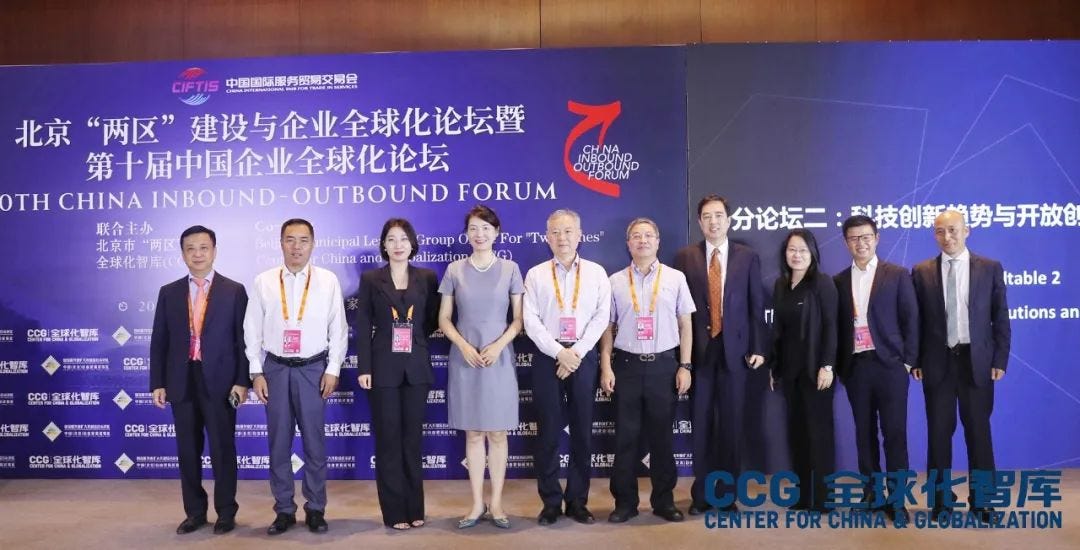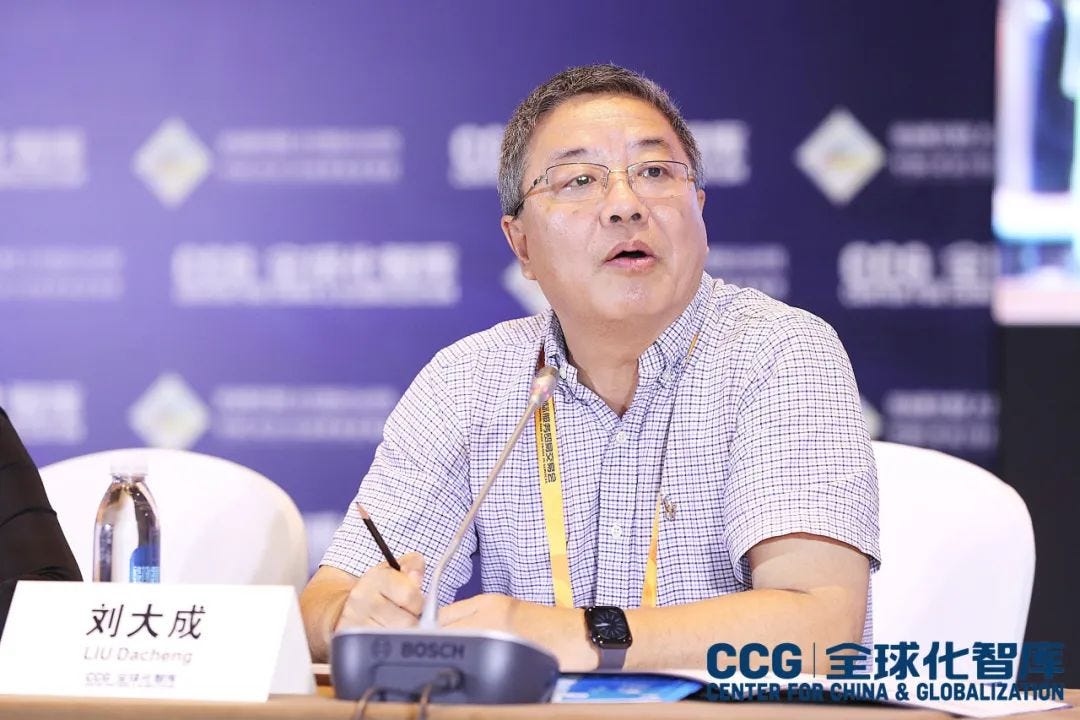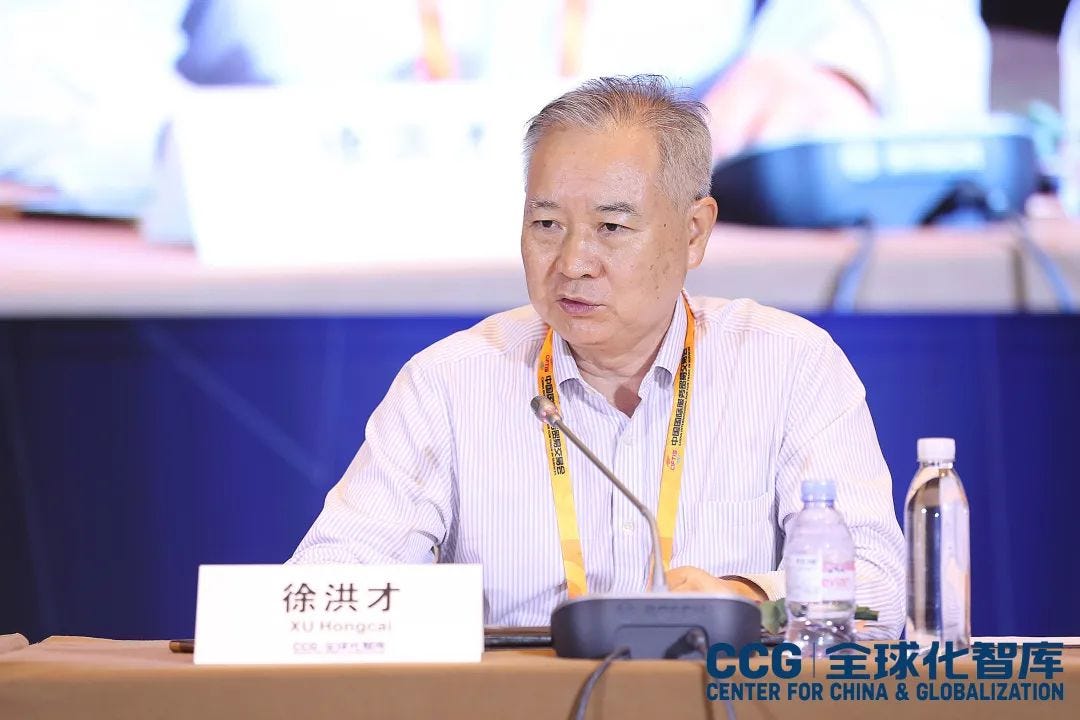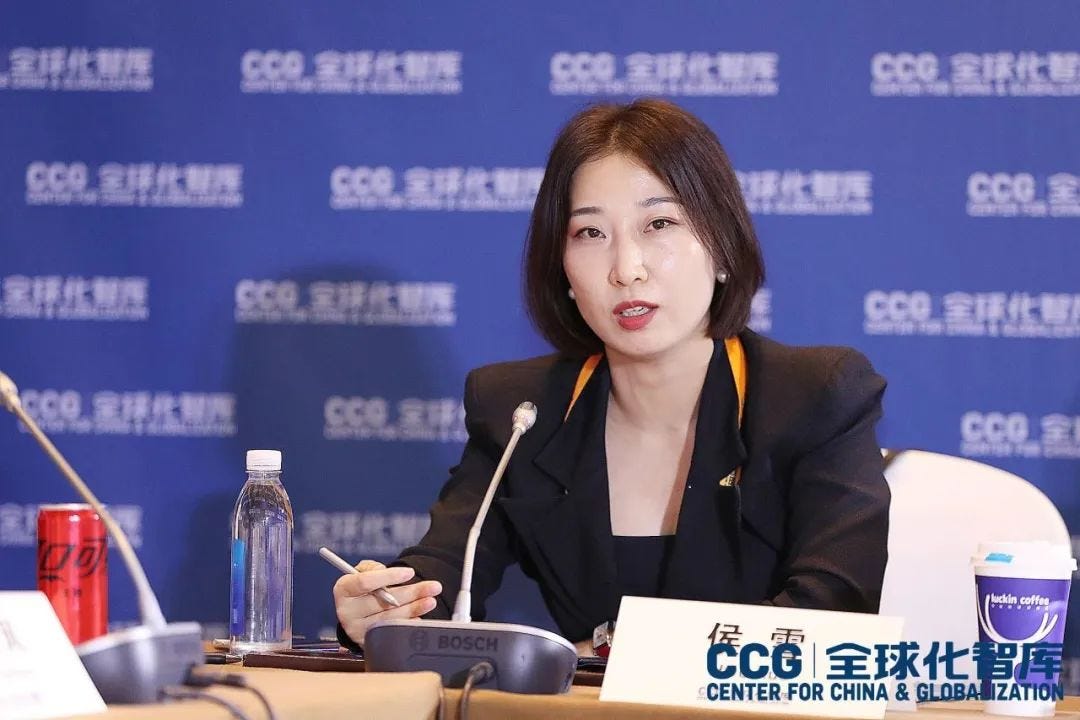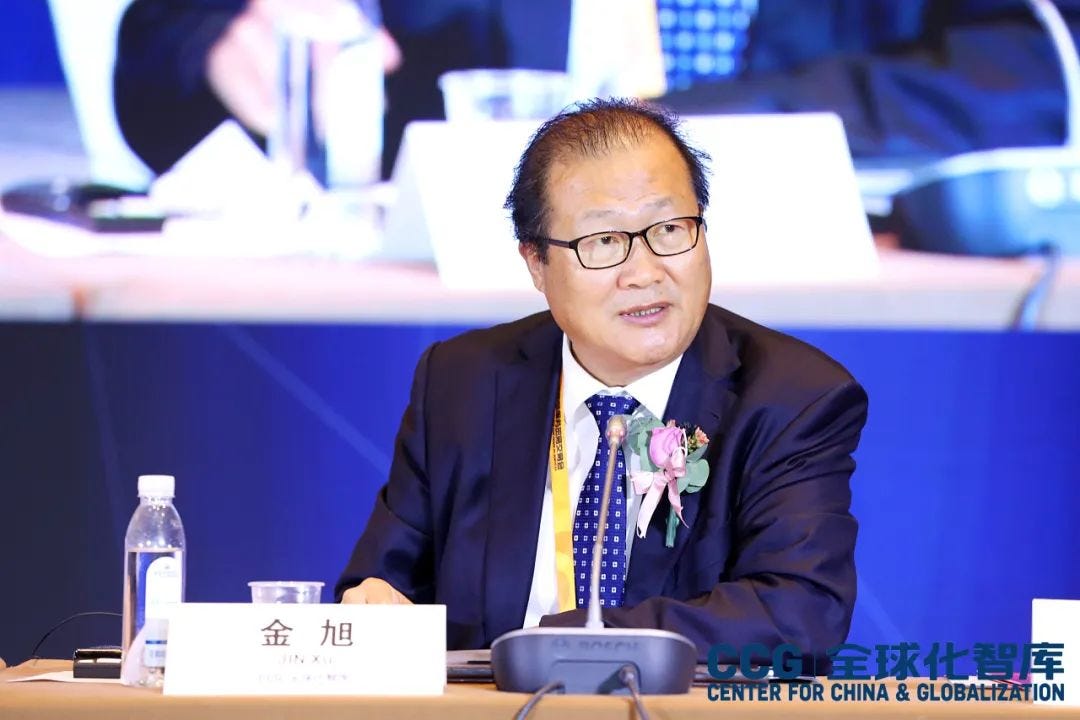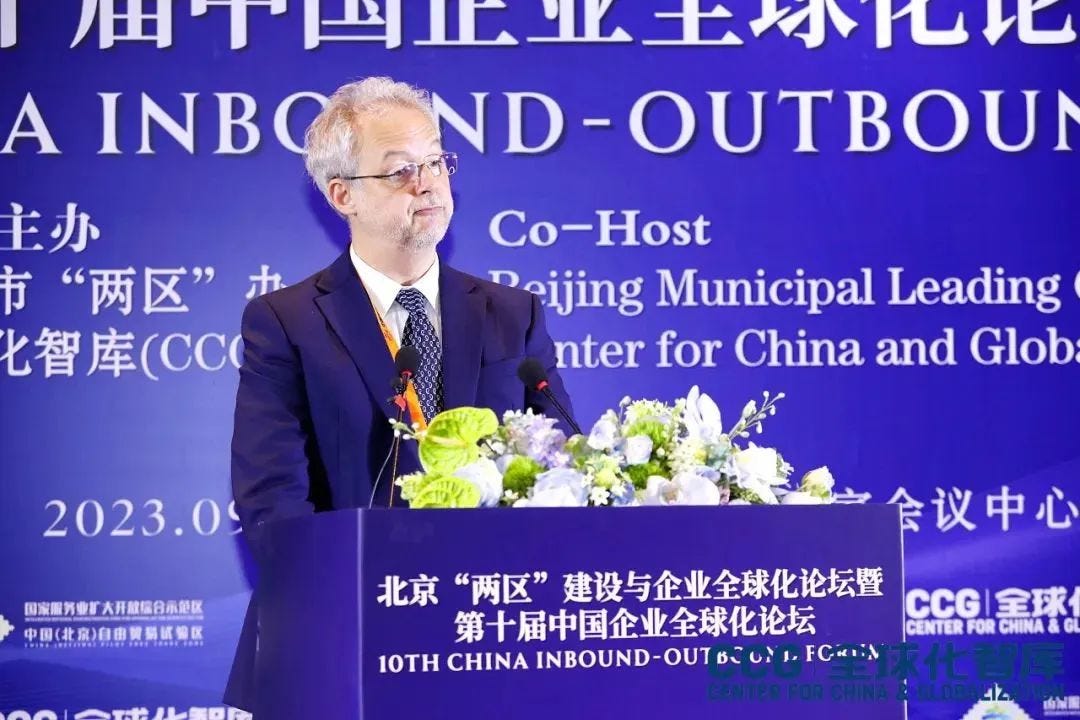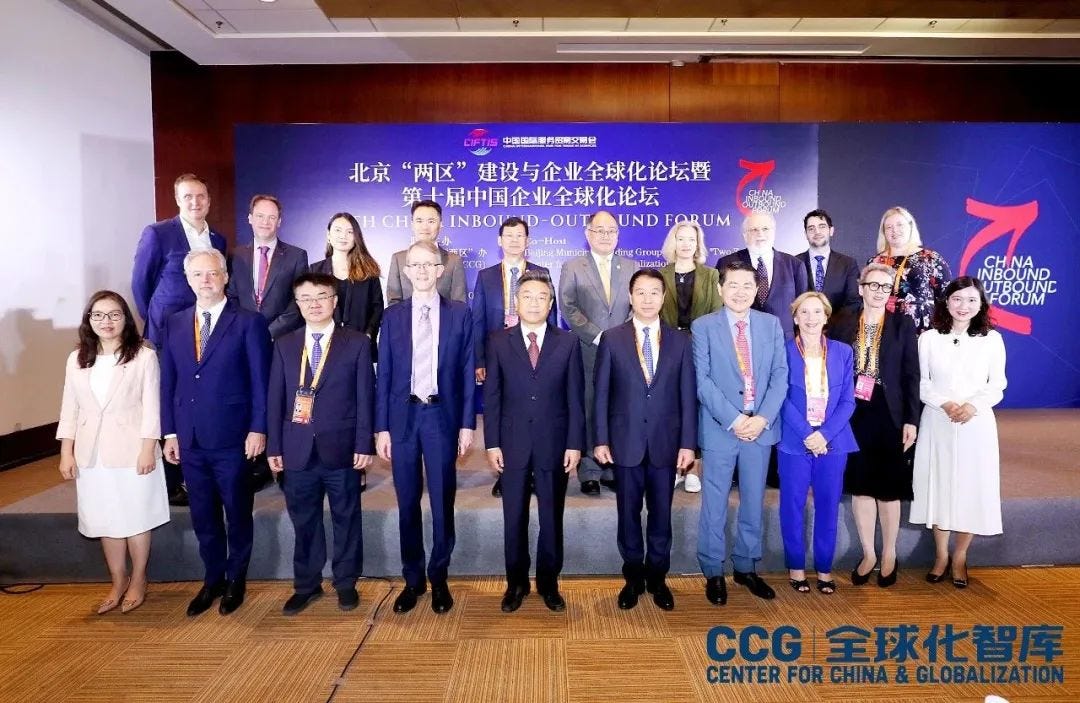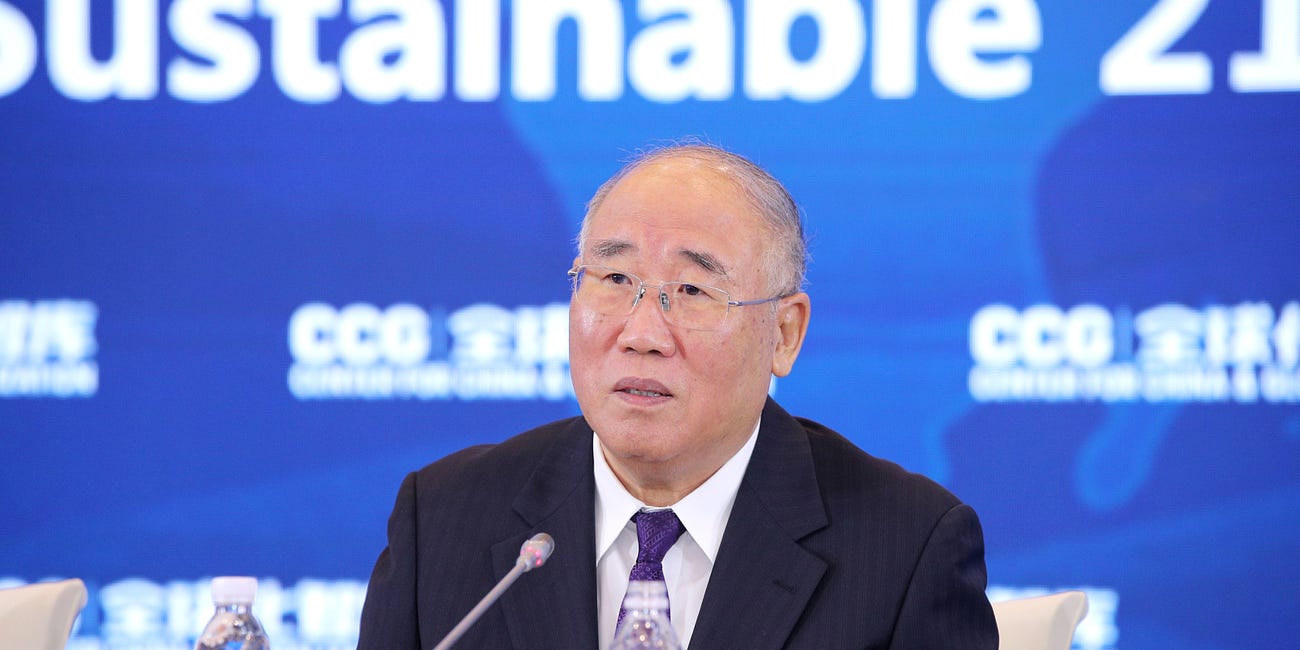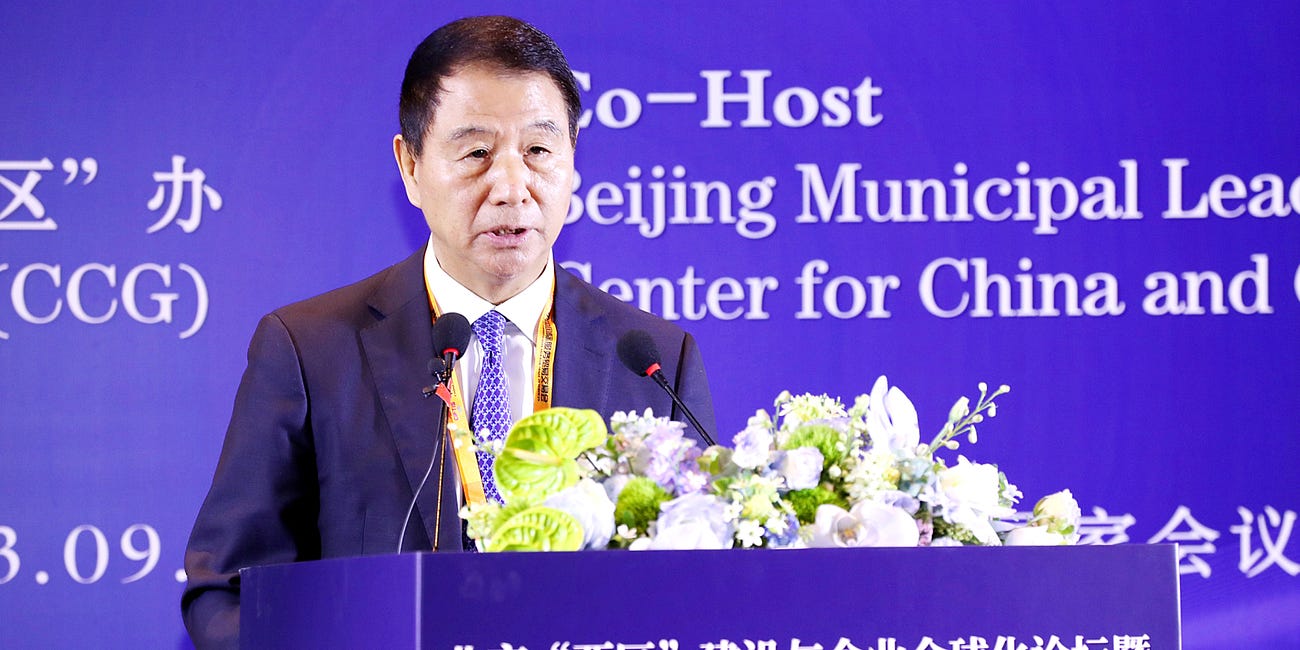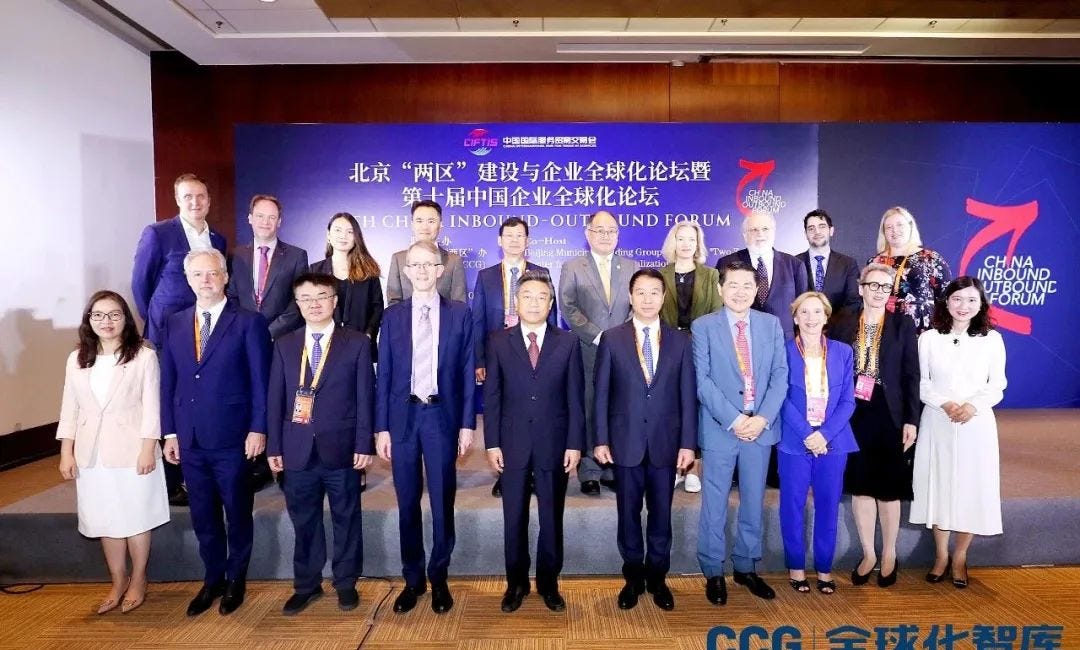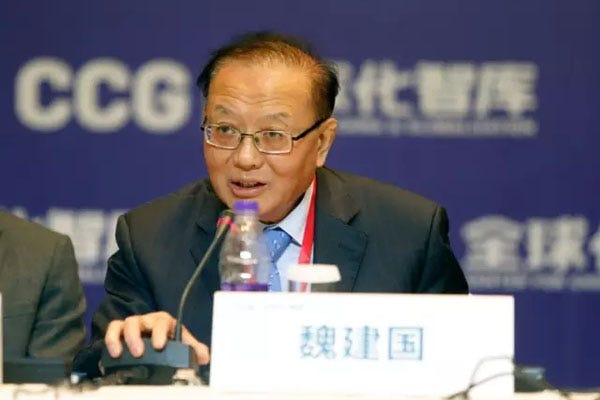Innovation in China: Odyssey in a digitalized age
Researchers and Head of the OECD Beijing Office shed light on the economics, geopolitics, and even historiography of innovation in China at the 10th China Inbound-Outbound Forum
At the 10th China Inbound-Outbound Forum as a part of the 2023 China International Fair for Trade in Services (CIFTIS), think tankers in China and the head of the OECD Beijing Office unveiled a rich and multifaceted landscape of innovation, against the backdrop of the seismic AI advancements and the ever-evolving business and political interactions between China and the United States.
Liu Dacheng, Vice President of the Internet Industry Research Institute, Tsinghua University believed the forces of digitalization are transforming the very fabric of society— therefore marking the next major shift in human civilization following the exit from the Malthusian cycle and entrance into the industrial age. Informatization had connected people with devices, while networking connected people with people; now, digitalization connects devices with devices, he said. He also highlighted the overarching global challenges of climate change and digitalization that overshadow geopolitical issues, including the war in Ukraine and China-U.S. tensions.
Xu Hongcai, Deputy Director of the Economic Policy Committee, China Association Of Policy Science (CAPS) took on a more domestic perspective, recognizing disparities between Chinese and U.S. innovation in terms of quality, initiative, and a favorable environment. He attributed these disparities to inefficiencies within Chinese government institutions and increasing protectionism in China-U.S. trade. However, he cautioned against exaggerating the notion of "decoupling" between China and the U.S.
Hou Xue from the China Center for Information Industry Development (CCIID) under China's Ministry of Industry and Information Technology (MIIT) highlighted the strong innovation capabilities in software development, information technology, wind energy, satellite technology, and application industries. She emphasized the need to transition from enterprise-centric innovation to collaborative efforts involving the government, industry, academia, and research institutions.
Jin Xu, President of China Association of International Trade called for rigorous implementation of lifting up trade barriers and creating a convenient, comfortable, and respectful environment for foreigners and foreign enterprises. His view resonated with that of Tamas Hajba, Head of the OECD Beijing Office, who, although recognizing China's vital role in global trade and its efforts to open up its markets, pointed out challenges related to rising trade barriers, particularly in digital economy sectors like computer services, which could undermine market confidence and hinder global economic recovery.
The Forum is co-hosted by CCG and Beijing Municipal Leading Group Office for “Two Zones,” referring to the national integrated demonstration zone for greater openness in the services sector and the pilot free trade zone characterized by scientific and technological innovation in Beijing.
Liu Dacheng, Vice President of the Internet Industry Research Institute, Tsinghua University
I am a researcher myself, having served as a professor at RWTH Aachen University in Germany from 2002 to 2003. Later, I was a professor at the Kenan-Flagler Business School at the University of North Carolina from 2011 to 2019. After that, I joined Tsinghua University. So, I would like to discuss technology innovation and open innovation from an educational perspective.
At the beginning of the reform and opening up, innovation in China was primarily led by universities. However, today, it is widely acknowledged that enterprises are the main drivers of innovation. What led to this change? It's actually part of a global shift in innovation. Economic historian Gregory Clark once said, "For 10,000 years, there was only one change in farming, the Industrial Revolution." Farming was initially constrained by what is known as the Malthusian cycle, until Industrial Revolution in Britain brought about the first true innovation; but it wasn't scientific but rather technological innovation. Maxwell's electromagnetism marked the advent of scientific innovation. During my time in Germany, I stayed in North Rhine-Westphalia, where the world's first industrial park, Ruhr Industrial Area, was located. By the 1860s, Germany had become a global leader in innovation. In 1895, the United States surpassed Britain in GDP to become the world's largest economy. However, it wasn't until 1944 when Vannevar Bush, Vice President and Dean of the School of Engineering at MIT, proposed Science: The Endless Frontier that the U.S. truly began to lead in scientific theory.
The power loom was a significant product of Britain's Industrial Revolution. It was brought to the United States by the British-born Samuel Slater, often hailed as the "Father of the American Industrial Revolution," who was then accused of treason by the Britons. Patent is such as core part of the major contradictions of free trade; innovation is always led by one or a few individuals, especially in the realm of fundamental theories. These theories are constantly confirmed or refuted by subsequent generations, forming knowledge and thus giving rise to the second significant change in Gregory Clark's thinking. The first change, according to Gregory Clark, extended human power, while this second change extended human intelligence. Recently, Tesla achieved 42 minutes of autonomous driving using just 2,000 lines of data. All other autonomous driving systems operate on tens of thousands of lines of data, making their hardware requirements much higher. Tesla's hardware is advanced, but what sets it apart is its ability to convert all the data into the best driver habits, so 2,000 lines are sufficient. This change aligns with the use of large models which have been covered by previous discussions today.
The future world is going to witness two irreversible trends. One is climate change, which will likely become an outdated phrase — this year, the UN Secretary-General has referred to it as "global boiling." The other is the change brought about by digitalization. In the past, informatization connected people with devices, while networking connected people with people; now, digitalization connects devices with devices. The world today is turning a completely new page. Over 60 years ago, the world was driven by information, and now it's driven by data, with large models having altered the development path of Artificial Intelligence. These two irreversible trends overshadow what are referred to as geopolitics, the war in Ukraine, and even the conflicts between China and the U.S.
How will China innovate in the future? I often invite Ray Dalio, Chairman of Bridgewater Associates, for discussions. He predicts that China's economy will surpass that of the U.S. by 2028 and has great confidence in this projection. However, although China now leads globally in terms of the number of research papers and patents, the point where China leads in terms of quality still remains uncertain. This will be a lengthy process. Let me share my views on how this goal can be achieved:
First, in the innovation process, it's crucial to consider the long-term perspective rather than seeking quick gains.
Second, it's essential to remain grounded in reality and provide an open environment for innovation. Silicon Valley's growth can be attributed, in part, to a balanced equation where 50% of its prosperity came from capital, another 50% from entrepreneurs, and perhaps an additional portion from innovators. In contrast, China often tends to swing to two extremes: either patent holders or capital dominates the scene.
In the agricultural era, the most crucial factors were land and labor. Following the Age of Exploration and the Industrial Revolution, land's significance diminished, giving rise to the paramount importance of capital and labor. With the advent of the Solow model in 1956 and the Marshall Plan in 1957, labor's role diminished further, while capital and innovation took center stage. However, the current landscape sees capital vigorously pursuing innovation and big data, resulting in a complete transformation.
Xu Hongcai, Deputy Director of the Economic Policy Committee, China Association Of Policy Science (CAPS)
Today's discussion revolves around innovation and the innovation ecosystem, and I'd like to share perspectives from both international and domestic standpoints.
Looking from an international perspective, it's clear that the world has undergone profound changes, especially with the increasing complexity of the strategic competition between China and the United States. The recent visit of the U.S. Secretary of Commerce to China further underscored the “small yard, high fence” situation in national security and the de facto "decoupling" between the two countries. Through reshaping the global supply chain, the U.S. is also revamping the global innovation ecosystem. The expiration of the "U.S.-China Science and Technology Cooperation Agreement (STA)," which had been renewed every five years for over four decades, has now run into an issue. The landscape of innovation cooperation between China and the U.S., as two major nations, is undergoing significant shifts.
Indeed, there are diverse perspectives within the United States as well. Recently, over a thousand American researchers signed an open letter addressed to U.S. President Joe Biden and the U.S. National Security Council, strongly advocating for the renewal of the STA with China. They recognized that the U.S. cannot monopolize innovation in all technology domains, and China has emerged as a global leader in many aspects of innovation; isolating China would politicize innovation and economic activities, which would ultimately be detrimental to future economic development.
From a domestic perspective, market mechanisms in China are playing a crucial role, emphasizing businesses as the main drivers of market innovation. However, the role of the government is also indispensable. Over the past four decades, China has seen many successful cases of innovation in China, as well as some areas where progress has been limited. Mega-cities like Beijing and Shanghai possess substantial innovation resources, but their innovation vitality in certain aspects still lags behind emerging cities like Shenzhen and Hangzhou. This suggests that institutional factors, such as the system and mechanism, may be at play.
In the past, China emphasized collaborative efforts between industry, academia, and research institutions, but many Chinese universities, including Tsinghua University and Peking University, as well as their affiliated enterprises and publicly-listed companies, have struggled with innovation. Recent events like the bankruptcy and restructuring of Peking University Founder Group and Tsinghua Unigroup have highlighted shortcomings in their innovation efforts. Therefore, while market mechanisms are effective, other factors need to work in harmony. For example, despite the successful inauguration of the ChiNext and STAR Market in Shenzhen and Shanghai, respectively, these markets have experienced declines of 20% to 30% in the past year, resulting in significant losses for investors. Clearly, the mechanisms supporting innovation in the financial sector need further refinement. This raises important questions about how to harness the decisive role of the market in innovation while effectively leveraging the government's role.
In conclusion, from an international perspective, the escalating geopolitical tensions and politicization pose significant disruptions to economic and innovation cooperation, the cornerstone of China-U.S. relations. This is an undesirable reality which must be confronted.
On the other hand, within existing constraints, there is room for maneuver and effort. Even with the current U.S. policy of "small yard, high fence," there are differences of opinion between Washington D.C., Silicon Valley, and Wall Street. Following the recent visit of the U.S. Secretary of Commerce to China, some have humorously suggested that she was endorsing Huawei smartphones, highlighting the complexity of business relations between China and the U.S. Indeed, the business dynamics between the two countries continue to function in an orderly and normal manner, rather than undergoing a simplistic, wholesale decoupling. The exaggerated rhetoric of escalating "decoupling" between China and the U.S. is not reflective of reality. Therefore, it is imperative for the forces within the business community, civil society, and academia to actively engage and exert a positive influence on policy formulation. This holds positive implications for the future development of our innovation ecosystem because, from a domestic perspective, the coordinated efforts of businesses, universities, and government departments must continually learn from experiences and lessons to achieve synergy.
Hou Xue, Deputy Director of the Department of International Cooperation, China Center for Information Industry Development (CCIID) under China’s Ministry of Industry and Information Technology (MIIT)
In my view, innovation today is no longer a solo endeavor but rather a collaborative symphony involving government, industries and academic and research institutes. Given this context, especially within the current framework of establishing a "dual circulation" model at both the international and domestic levels, open innovation holds immense significance and plays a vital role. I'd like to share some personal insights on this from two perspectives.
First, I'd like to discuss global trends in technological innovation. With the advancement of the new technological revolution and industrial transformation, international powers are undergoing profound realignments, leading to significant changes in the global landscape of technological innovation. I believe there are four crucial key changes:
The widespread emergence of new technologies such as big data, the Internet of Things, and large-scale models is poised to have disruptive and substantial impacts on future economic growth. These effects are still evolving, and I predict significant disruptive changes in the next 5-10 years.
Data has become a critical factor of production and a strategic resource. The dependence of current technological innovation and production on data resources is continuously increasing.
A reshaping and change in the international innovation landscape. With the rise many Eastern countries, there has been a significant change in their innovation speed and quality, with multiple innovation centers shifting towards Eastern countries worldwide.
I believe the paradigm of technological innovation has changed, transitioning from the 1.0 era to the 3.0 era. You may ask, what is 1.0, and what is 3.0? Technological innovation 1.0 was confined within enterprises, while technological innovation 2.0 involved multiple different entities, creating an open innovation system through collaboration between government, industry, academia, and research institutions. Industrial innovation 3.0 emphasizes following biological laws and focuses on building an open innovation ecosystem.
Second, I'd like to provide an overview of the current situation in our country within the context of this open innovation ecosystem. The CCIID Think Tank specializes in research in the fields of industry and information technology, and has made predictions regarding China's industrial policies and its stage of industrial development. The CCIID believes China is currently in a strategic period of "Chinese-style modernization." China has long been engaging with the international community, actively fostering an environment conducive to international scientific and technological exchange and cooperation. Currently, China has established scientific and technological cooperation relationships with over 160 countries and regions and participates in over 200 international multilateral organizations. With the vision of building a community with a shared future for mankind, China is continually advancing a win-win scenario for innovation, especially in international technological innovation.
I believe China’s efforts can be summarized from two perspectives. First, it continuously promotes the sharing of innovation resources, particularly through scientific and technological cooperation such as establishing joint laboratories and collaborative research, with countries involved in the Belt and Road Initiative (BRI) and BRICS countries. Second, China is committed to more flexible and effective ways of exporting technological products to the world. This upholds multilateralism and the co-innovation of a free trade system, fostering a fair and just global technological innovation governance system.
I have conducted extensive research on Innovation 3.0 based on big data. In the context of businesses, innovation stands as an enduring pursuit. As part of this research, an in-depth data tracking effort was carried out, encompassing 10,000 "specialized and innovative" small and medium-sized enterprises (SMEs) across the country. The final analysis, based on innovation potential, revealed that sectors such as software development, information technology, wind energy, satellite technology, and application industries display remarkably robust innovation capabilities. These sectors hold significant promise for evolving into China's cornerstone industries through the mechanism of disruptive innovation. Big data is anticipated to play a crucial role in driving the development of these sectors.
Jin Xu, President of China Association of International Trade
I'd like to express my gratitude to the CCG for providing us with this wonderful opportunity to engage in open and enjoyable discussions, where we can freely exchange viewpoints and ideas. Over the past decade, I've had the privilege of working at the Chinese Consulate in the U.S., the Chinese Embassy in the UK, and the Department for Americas and Oceania at the Ministry of Commerce. During this time, I've had the chance to interact with foreign investors in Europe and the Americas, who make up most of the foreign investment in China and hold diverse opinions about the country.
It's worth noting that the People's Republic of China (PRC) are among the most frequently debated topics in the U.S. Congress, with an extremely wide spectrum of attitudes. Some are excited by China's remarkable achievements, while many others have various reservations about China's practices, culture, and policies.
Returning to the present, as we gather here, we are also discussing the "PRC," but in this context, it stands for China's "Price" (P), "Risk" (R), and "Confidence" (C), which includes several key areas of concern:
Market access barriers, most of which have been eliminated since the establishment of Beijing's "two zones," [a demonstration zone for the service industry approved in 2015 and a free trade zone approved in 2020] making Beijing an attractive destination for foreign investment.
Overly complex administrative approvals have posed challenges for business operation.
Intellectual property protection. One of the top priorities in working abroad is attracting foreign businesses and bringing excellent enterprises and high technology to China. However, some foreign companies are concerned about intellectual property issues. For example, they fear that their products may be replicated by Chinese manufacturers shortly after entering the Chinese market.
Trade barriers. Opinions on trade barriers vary, but overall, China needs not only sound policies, actions, and effective communication but also rigorous implementation. For example, creating a convenient, comfortable, and respectful environment for foreigners requires fundamental improvements in policy governance. Furthermore, China must continue to enhance its business environment, ensuring equal treatment for small and medium-sized enterprises (SMEs). This is directly linked to the confidence of all stakeholders.
It's evident that many issues require careful consideration. Naturally, more open and robust communication is called for to address them. It is only through meaningful dialogue that China and the world can understand each other's perspectives and effectively address mutual concerns.
Tamas Hajba, Senior Advisor for China and Head of the OECD Beijing Office
Thank you Mabel, Vice Chairman Hou, Vice Minister Yi, Ambassador Fletcher, dear Henry,
I’m pleased to join the 10th Inbound-Outbound Forum at the China Fair for Trade in Services, and I’d like to thank the Beijing Municipal Government and also the Centre for China and Globalisation for inviting the OECD to this important event.
Global services trade is a key driver of international commerce. Since 2014, exports of services have outpaced the development of both merchandise exports and the global gross domestic product. They now account for roughly half of global commerce in terms of added value. The rapid expansion has been fueled by technology and improved communication infrastructure, making cross-border trade of services simpler. However, during the COVID-19 pandemic, the services trade declined more than the merchandise trade, particularly due to the international travel restrictions.
Foreign direct investment (FDI) has also contributed significantly to global economic growth. OECD estimates for the first quarter of 2023 indicate that the global FDI flow tripled from the very low levels recorded in the fourth quarter of 2022. Nevertheless, global FDI flows remained 25% below the level recorded in the first quarter of 2022 on an annual basis. In 2022, major FDI recipients saw a decline in FDI inflows, particularly China and the United States, due in part to a decline in new investment activities.
The global economy as a whole is turning a corner, but it still has a long way to go to achieve robust and sustainable growth. The OECD forecasts that global growth will reach 2.7% in 2023 and gradually increase to 2.9% in 2024, despite adverse risks. According to the OECD’s Economic Outlook, China's growth will rebound to 5.4% in 2023 (from 3.0% in 2022) and 5.1% in 2024.
Service sector activity has begun to recover and has emerged as a key development driver so far this year, particularly due to robust demand in China and the United States. A healthy global market for the exchange of services will be required to maintain this momentum. However, rising trade barriers in services sector, especially for services that are essential to the digital economy, such as computer services, may limit this demand's ability to drive global economic growth.
China is a major contributor to global trade in services, accounting for 6.4% of the global total value of services trade. It has achieved significant progress in liberalising its service sector, and there are opportunities to build on this process. The “Two Zones” project implemented by the Beijing Municipal Government is an important step in this direction. There is also a great potential for further expansion as the country’s contribution to global services trade is half of its contribution to global merchandise trade.
China is also one of the largest recipients of foreign direct investments due to its market potential, high-quality investment infrastructure, and skilled labour force. However, its accumulated stock relative to GDP at around 20%, compared to the OECD average of 45%, indicates that there are more opportunities for growth.
Long-term cooperation between the OECD and China has contributed to the global policy dialogue on trade in services and investment. It has also provided policy support for measures, such as those envisioned in the fourteenth Five-Year Plan, aimed at fostering an environment that is increasingly conducive to service trade liberalisation and investment.
We are cooperating with the Ministry of Commerce and the Development Research Centre of the State Council, as well as the Beijing Municipal Government, to further explore the application of the OECD Services Trade Restrictiveness Index (STRI) to inform discussions on services reform in China. Closing half of the gap between China's current level of restrictiveness, as measured by the Index, and best practice could reduce trade costs by more than 20%, thereby improving the economy's competitiveness. In addition, last year, the Beijing Municipal Government and the Ministry of Finance co-organized with the OECD a series of policy trainings on OECD standards, instruments, and policies that measure and support an enabling business environment.
These events, which were attended by officials and experts from various government ministries and local governments, discussed the OECD's Product Market Regulation indicator, the FDI regulatory restrictiveness index, the trade facilitation indicators, and public procurement policies.
Importantly, Chinese participants have shared their experiences and policy solutions intended to enhance the business environment, increase competition, and stimulate business vitality. This has not only informed the global policy community, but also contributed to the discussions on these crucial issues.
Allow me to take this opportunity to thank the Beijing Municipal Government for hosting these events and providing support for the OECD-China policy exchanges. The OECD is eager to continue this mutually beneficial collaboration with the Beijing government and other relevant government departments. I would also like to take this opportunity to commend the Center for China and Globalization on providing its excellent platform for much-needed dialogue on policy exchanges.
In conclusion, China's reform agenda can provide a significant boost to its services trade and, in turn, to global development.
The OECD looks forward to further strengthening its long-standing partnership with China, to further support its transition from an investment-led to a consumption-driven growth model, in which the services sector will play a central role. I wish all of you fruitful and positive exchanges for today's discussion.




